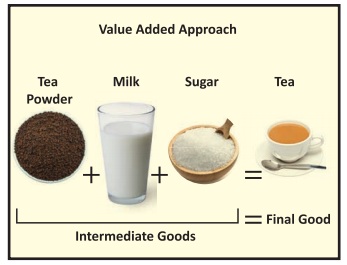Methods of GDP Calculating, Importance, Limitations, Estimation of GDP | Economics - Gross Domestic Product (GDP) | 10th Social Science : Economics : Chapter 1 : Gross Domestic Product and its Growth: an Introduction
Chapter: 10th Social Science : Economics : Chapter 1 : Gross Domestic Product and its Growth: an Introduction
Gross Domestic Product (GDP)
Gross Domestic Product (GDP)
Produced in the country: GDP of India includes only
the market value of goods and services produced in India. For example the
market value of apples produced in Kashmir are included in our GDP since
Kashmir is in India. The market value of apples produced in California, even if
they are sold in Indian markets, are not included in our GDP because California
is in the U.S.
Produced during a time period
The GDP of a country measures the market value of
goods and services produced only during the specified time period. The goods
and services produced in earlier periods are not included.
In India
the GDP is measured both annually and quarterly. The annual GDP is for a financial
year which is from April 1st of say 2017 to March 31st 2018.
The modern concept of GDP was first
developed by Simon Kuznets for a US Congress report in 1934.
Methods of GDP Calculating
1. Expenditure Approach: In this
method, the GDP is measured by
adding the expenditure on all the final goods and services produced in the
country during a specified period. Y=C+I+G+(X−M)
2. The Income Approach: This
method looks at GDP from the
perspective of the earnings of the men and women who are involved in producing
the goods and services. The income approach to measuring GDP (Y) is Y = wages +
rent + interest + profit
3. Value-Added
Approach: A cup of tea served to you in
a hotel is a “final good”. The goods used to produce it , tea powder, milk, and
sugar, are “intermediate goods” since they form a part of the final good, the
cup of tea. One way to measure the market value of the cup of tea is to add the
value produced by each intermediate good used to produce it. The sum of the
value added by all the intermediate goods used in production gives us the total
value of the final goods produced in the economy.

Value added method
Tea powder + Milk + Sugar = Tea
Value of intermediate goods = Value of final goods
Importance of GDP
1. Study of Economic Growth.
2. Problems of inflation and deflation.
3. Comparison with developed countries of the
world.
4. Estimate the purchasing power.
5. Study of Public Sector.
6. Guide to economic planning.
Limitations of GDP
1. Several important goods and services are left out of the GDP: The GDP includes only the goods and services sold in the market. The services provided by parents to their children is very important but it is not included in the GDP because it is not sold in the market. Likewise clean air, which is vital for a healthy life, has no market value and is left out of the GDP.

2. GDP
measures only quantity but not quality: In the 1970s schools and banks
did not permit the use of ballpoint
pens. This is because the ones available in India were of very poor quality.
Since then, not only has there been a substantial increase in the quantity of
ballpoint pens produced in India but their quality has also improved a lot. The
improvement in quality of goods is very important but it is not captured by the
GDP.
3. GDP
does not tell us about the way income is distributed in the country: The GDP of a country may be growing rapidly
but income may be distributed so unequally that only a small percentage of
people may be benefitting from it.
4. The
GDP does not tell us about the kind of life people are living: A high
level of per capita real GDP can go
hand-in-hand with very low health condition of people, an undemocratic
political system, high pollution and suicide rate.
Estimation of GDP
The Central Statistical
Organisation (CSO), under the Ministry of Statistical department keeps the records.
It’s processes involves conducting an annual survey of industries and
compilation of various indexes like the Index of Industrial Production (IIP)
Consumer Price Index (CPI) etc.
Related Topics